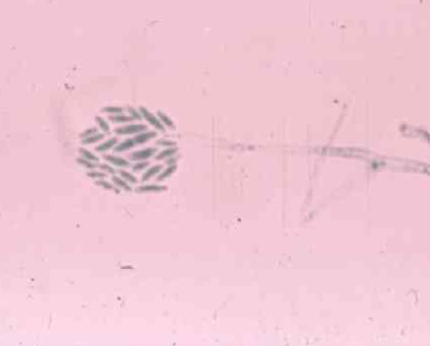Advanced Micro Exam 3
5.0(6)
5.0(6)
Card Sorting
1/60
Earn XP
Description and Tags
Study Analytics
Name | Mastery | Learn | Test | Matching | Spaced |
|---|
No study sessions yet.
61 Terms
1
New cards
Which two bioterrorism organisms can show bipolar staining on the gram stain?
Yersinia pestis & Burkholderia pseudomallei
2
New cards
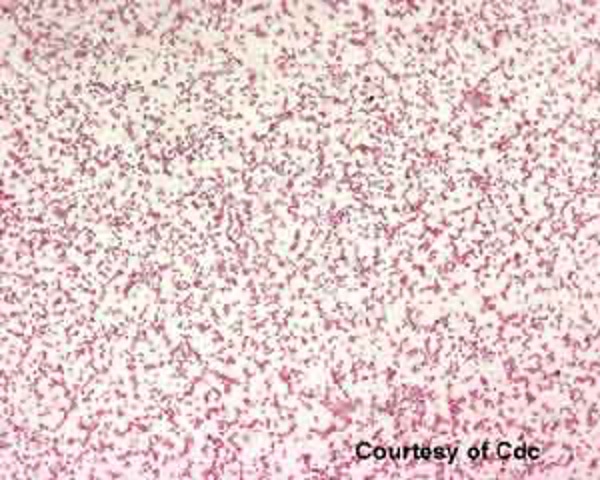
Illustration of a Gram-negative, oxidase negative organism on chocolate agar at 72 hours with no growth on MacConkey agar. It is most likely to be:
Francisella tularensis
3
New cards
What are some things to consider with potential bioterrorism agents. Select all that apply.
Patient travel history, gram stain results, growth and/or no growth on routine culture plates
4
New cards
This group of laboratories are responsible for specialized strain characterization and tracking biothreat agency activity:
National labs
5
New cards
A vacationing man from Georgia came into the family practice clinic complaining of respiratory problems. A direct Calcifluor White exam from a sputum specimen revealed a large, thick-walled yeast with broad based buds. The most likely organism would be:
Blastomyces dermatitidis
6
New cards
"Valley Fever" is:
1° Coccidioidomycosis
7
New cards
Thick-walled yeast cells with single buds attached by a broad base, which are observed in an aspirated clinical specimen, indicates that the etiologic agent is probably:
Blastomyces dermatitidis
8
New cards
An intracellular mycotic infection of the Reticulo-endothelial system would implicate which of the following:
Histoplasma capsulatum
9
New cards
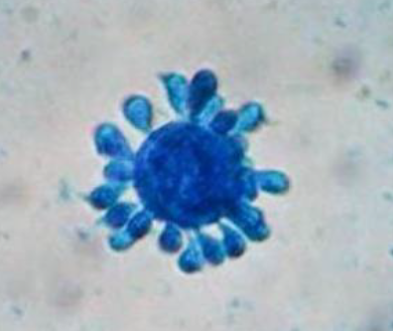
Exudate from a lesion of the mouth of a patient in South America was sent to the lab and inoculated for a fungal culture. The mold phase of an organism grew on PDA showing a folded, white, glabrous colony and the yeast phase showed cream, waxy colonies. The lactophenol blue stain of this organism is pictured below. What is organism identification?
Paracoccidioides brasilliensis
10
New cards
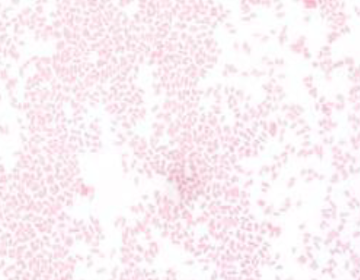
You suspect the organism pictured below is Yersinia pestis. You performed biochemical tests to try to rule out this organism. Which of the following results would help to confirm your suspicions that it is Yersinia pestis?
Catalase positive
11
New cards
Bacillus anthracis is primarily a disease of animals. This condition is known as:
Anthrax
12
New cards
Which of the following organisms grows on MacConkey agar?
Yersinia pestis
13
New cards
What is the role of a sentinel laboratory?
Early detection and rule-out of biothreat agents
14
New cards
A key characteristic of Bacillus anthracis is:
Non-hemolytic on sheep blood agar
15
New cards
A key characteristic of Yersinia pestis is:
Gram-negative bacillus
16
New cards
Yersinia pestis is primarily transmitted by:
Fleas
17
New cards
Tuberculate macroconidia are characteristic of:
Histoplasma capsulatum
18
New cards
Conditions that would enhance the growth of the yeast phase of a dimorphic (biphasic) fungus include:
Incubation at 35 C-37 C
19
New cards
Fluid from a cutaneous hand lesion surrounded by edema was cultured as a routine wound. A non-hemolytic “medusa head” colony was isolated on blood agar which showed gram positive rods in chains. The most likely causative organism is:
Bacillus anthracis
20
New cards

The colony and gram stain pictured below was isolated from a patient with a lesion of the skin that developed into black eschar. The MLS working the bench suspects this is a bioterrorism organism. What organism is the MLS thinking this could be?
Bacillus anthracis
21
New cards
Primary coccidioidomycosis is usually an infection of the:
Lungs
22
New cards
Bacillus anthracis may cause a pulmonary infection known as:
Wool sorters disease
23
New cards
Francisella tularensis commonly infects:
Rabbits
24
New cards
Coccidioides immitis has the following characteristic:
Dimorphic
25
New cards

Pictured below is a culture and tease prep from an organism found in a sputum specimen. What is the identification of this organism?
Coccidioides immitis
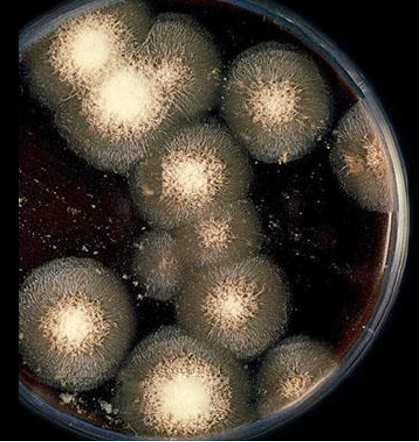
26
New cards
A sputum sample submitted for fungus culture should be inoculated to which of the following media?
PDA, IMA, mycosel
27
New cards
The systemic pathogen, which is dimorphic, with tuberculate macroconidia and small oval microconidia in the mold phase, is:
Histoplasma capsulatum
28
New cards
Which of the following characteristics of an isolate would suggest the organism is F. tularensis:
Gram-negative coccobacillus, slow growing at 35-37°C on sheep blood agar and chocolate agar, oxidase negative
29
New cards
Isolation of a gram negative rod with bipolar staining, from a blood culture of a critically ill patient, yielded colonies exhibiting a rough, hammered copper appearance within 48 hours. Select the most appropriate tests used to rule out the possibility of a bioterrorism organism.
Catalase, oxidase, indole
30
New cards
Blastomyces has the following characteristic
Dimorphic
31
New cards
In the examination of pus for the presence of Paracoccidioides brasiliensis it is necessary to look for:
multiple-budding yeast which may be resemble a "pilot's wheel"
32
New cards
33
New cards
Of the fungus below, which is endemic in Eastern United States, found in the soil and can be difficult to isolate in the laboratory?
Blastomyces dermatitidis
34
New cards
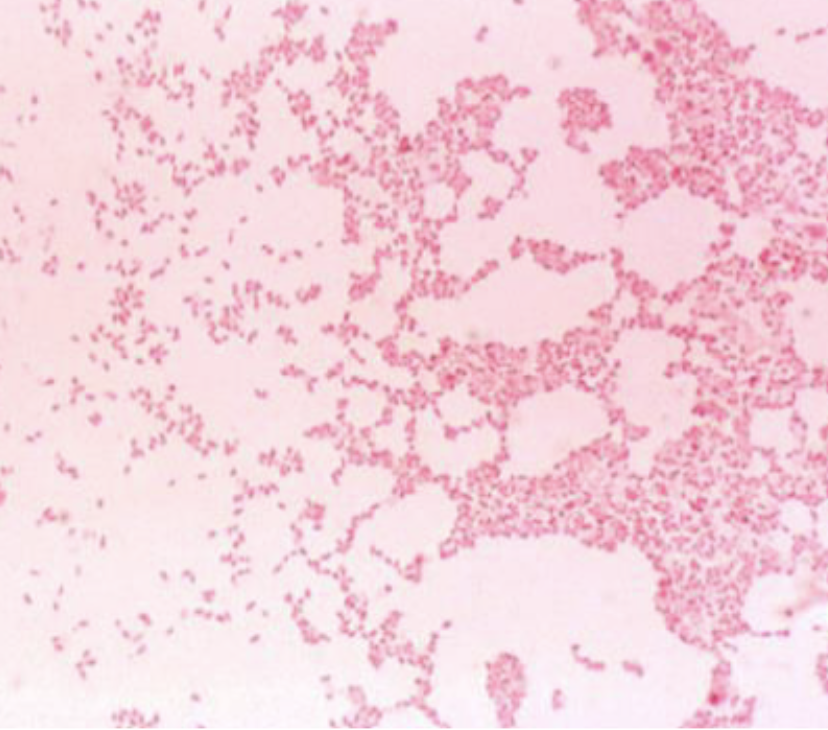
Gram stain illustration. This catalase positive, oxidase positive organism is most likely to be:
Brucella species
35
New cards
The tissue form Coccidioidomycosis is a (n):
spherule
36
New cards
Which of the following fungal infections is endemic in the Southwestern United States desert regions?
Coccidioidomycosis
37
New cards
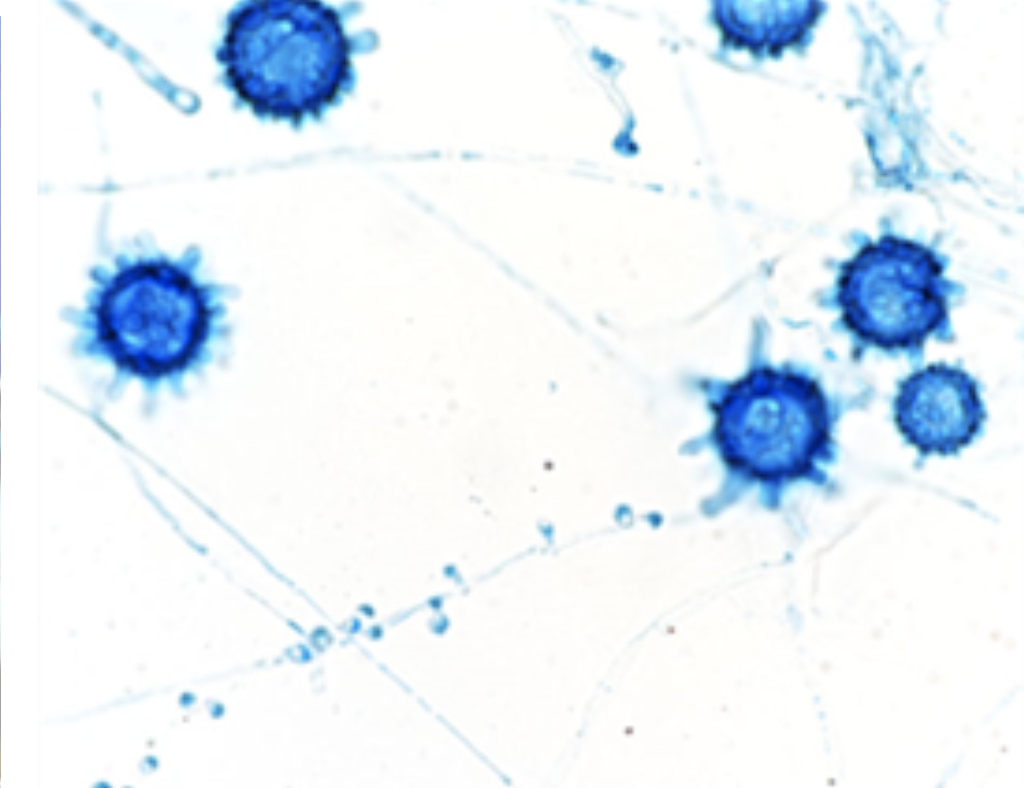
An organism was isolated from a induced sputum specimen from a patient living in the Midwestern United States. Pictured below is the colony from Sab Dex agar and a lactophenol blue tease mount. What is the identification of this organism?
Histoplasma Capsulatum
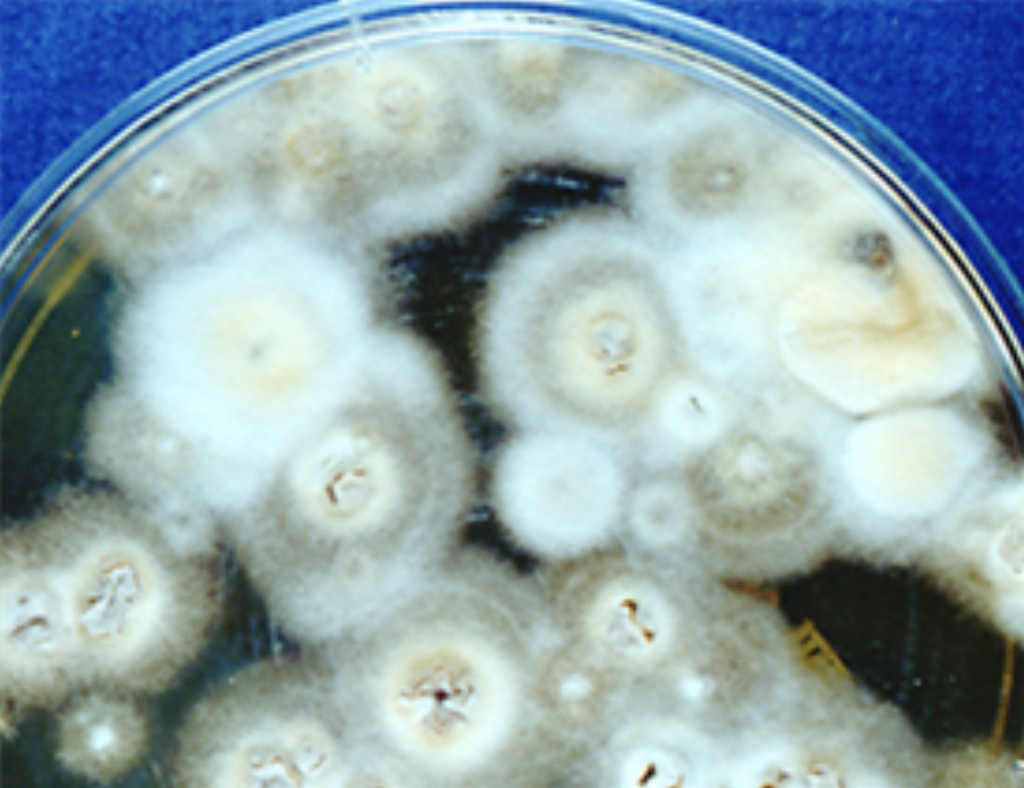
38
New cards
If you were considering a diagnosis of a systemic fungal infection, what would be the most likely specimen to collect to confirm this diagnosis?
sputum
39
New cards
Intracellular yeast forms seen in macrophages would implicate which of the following:
Histoplasma capsulatum
40
New cards
When collecting suspected Clostridium botulinum toxin specimens, clinical laboratories should:
Notify state public health laboratory
41
New cards
A 40-year-old male was admitted to the hospital with an acute respiratory tract infection. Sputum specimens were collected for bacterial and fungal cultures. Five days after inoculation, growth appeared on mycosel agar as a membranous colony growing close to the surface of the agar. A few days later, the colony was white and cottony. A preparation was made with lactophenol cotton blue from the colony demonstrates septate hyphae with arthroconidia (arthrospores) in alternating cells. Which of the following is the MOST probable identity of the fungus?
Coccidioides immitis
42
New cards
Histoplasma capsulatum has the following characteristic
Dimorphic
43
New cards
If presented with environmental samples received from a possible bioterrorism event, clinical laboratories should do all of the following EXCEPT:
Process the environmental samples associated with the bioterrorism event
44
New cards
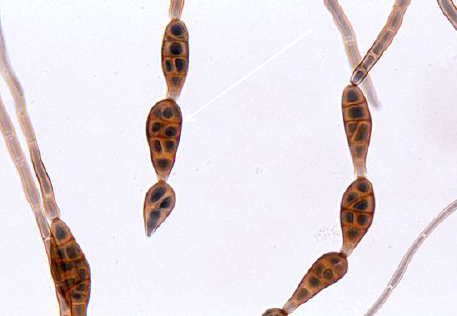
Based on the colony and microscopic morphology pictured below, what is the genus identification of the organism isolated?
Alternaria
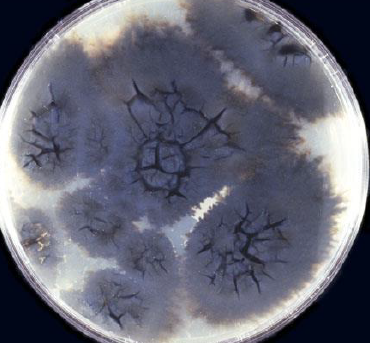
45
New cards
The description, "The organism develops peppery black dots on top of the mycelium, tends to fill the tube in 2-3 days, and has rhizoids directly opposite of the sporangiophores," would implicate which of the following:
Rhizopus
46
New cards

The oval or curved multi-celled, dark-staining macroconidia divided by transverse septa seen in this image is characteristic of:
Curvularia
47
New cards
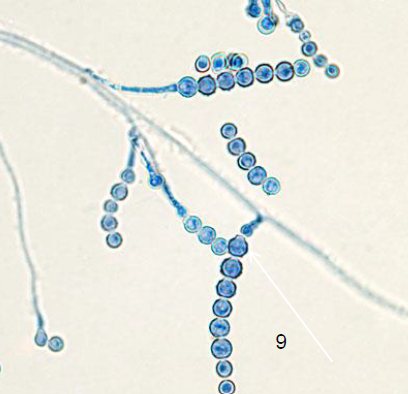
Based on the colony and microscopic morphology pictured below, what is the genus identification of the organism isolated?
Scopulariopsis
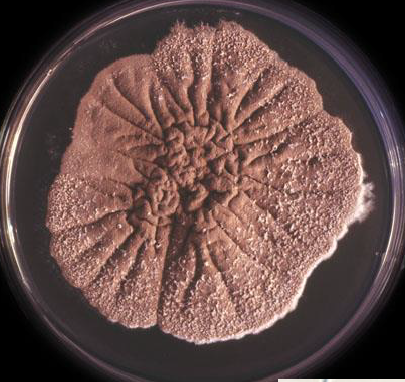
48
New cards
Curvularia sp. causing eye infections and mycetomas may be identified by having:
large conidia, usually 4 celled that appear to be curved due to swelling of a central cell
49
New cards
Darkly pigmented hyphae are seen on a KOH exam of a tissue specimen. The organism grows within 3 days into a dark gray colony. Microscopic examination reveals club-shaped conidia in chains with both transverse and longitudinal septations. The organism is identified as:
Alternaria spp.
50
New cards

Based on the colony and microscopic morphology pictured below, what is the genus identification of this isolate?
Penicillium
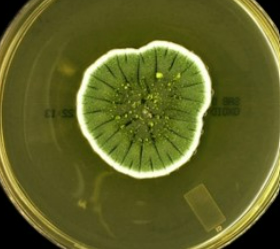
51
New cards
An opportunist, which may cause nail infections, is:
Fusarium spp.
52
New cards
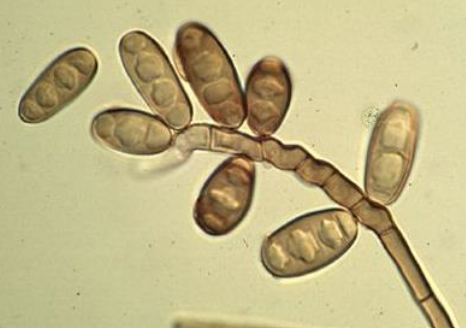
This fungus can be a contaminant but can cause infections in the lungs, skin and eyes. What is the identity of this organism?
Bipolaris
53
New cards
Which two fungi look similar microscopically?
Bipolaris & Exserohilum
54
New cards

Illustrated in the image is a fungus colony on Sabouraud’s dextrose agar. Note the cottony surface, and pink pigmentation. The lactophenol blue stain is pictured as well. What is the genus identified of this isolate?
Fusarium
55
New cards
An opportunist commonly found in eye infections with a lavender colony, sickle shaped, multi-septate macroconidia, and oval one to two celled microconidia is identified as:
Fusarium sp.
56
New cards
A fungus microscopically resembling Penicillium, but having "spiny, lemon-shaped" conidia is:
Scopulariopsis
57
New cards
A rapidly growing, hyaline, non-septate mold which fills the culture plate with floccose aerial mycelia and which has branching sporangiophores but no rhizoids is descriptive of:
Mucor
58
New cards
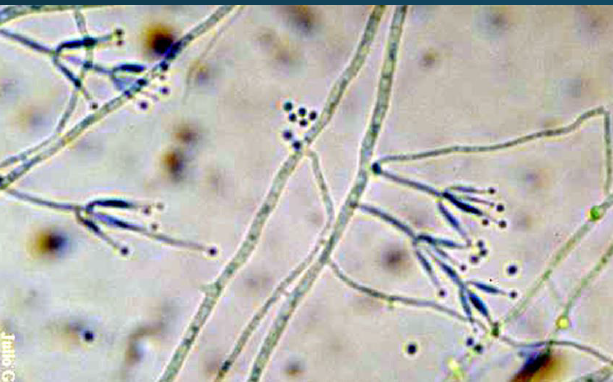
An eye fungal culture was submitted on a patient and a fungus grew within 3 days. The colony morphology of the organism was white with a light yellow reverse and the lactophenol stain is pictured below. Based on this information, what is the identity of this organism?
Paecilomyces
59
New cards
A mold isolated from a nail infection grew in 3 days. It was fluffy and white. Microscopically it had delicate tapering conidiophores and one-celled, oblong conidia in clusters at the tip of the conidiophore. The organism is identified as:
Acremonium sp.
60
New cards
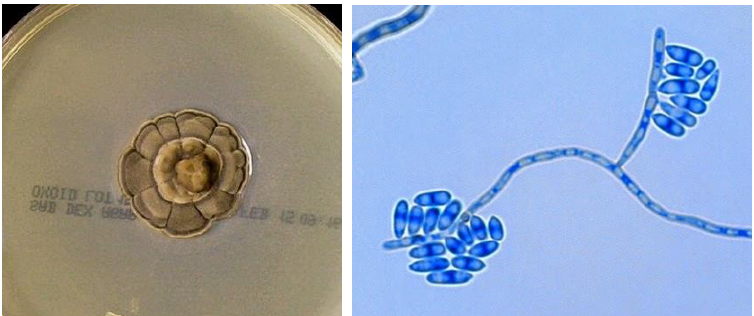
The organism pictured below was obtained from a skin lesion characteristic of phaeohyphomycosis. The reverse side of the colony was black. What is most likely the identification of this fungi?
Exophiala jeanselmei
61
New cards
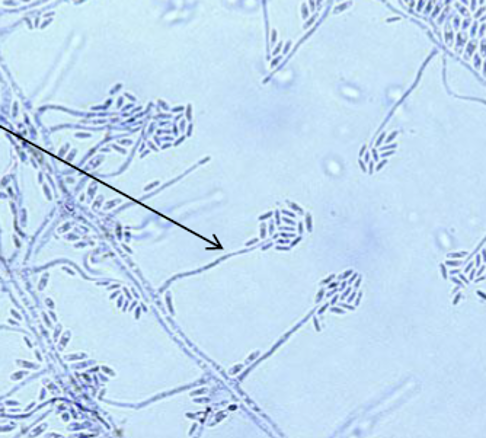
Given the images below, what is the presumptive identification of this organism?
Acremonium sp.
